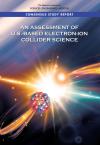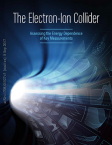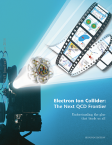JEFFERSON LAB SEARCH
News
Status
More information about the status of an electron-ion collider can be found in the documents linked below. In 2018, the National Academies of Sciences, Engineering and Medicine issued a report, “An Assessment of U.S.-Based Electron-Ion Collider Science.” Following the report, the directors of Thomas Jefferson National Accelerator Facility and Brookhaven National Laboratory issued a joint statement of support. More information about the impetus for building an electron-ion collider can be found in the 2015 Long-Range Plan, issued by the Nuclear Science Advisory Committee..
Benefits

Beyond sparking scientific discoveries in a new frontier of fundamental physics, an Electron-Ion Collider will trigger technological breakthroughs that have broad-ranging impacts on human health and national challenges. Research on the technologies needed to make this machine a reality is already pushing the evolution of magnets and other particle accelerator components.
Some of these advances could lead to energy-efficient accelerators, thereby dramatically shrinking the size and operating costs of accelerators used across science and industry for example, to make and test computer chips; to deliver energetic particle beams to zap cancer cells; to study and design improved sustainable energy technologies such as solar cells, batteries, and catalysts; and to develop new kinds of drugs and other medical treatments. New methods of particle detection developed for an EIC could also lead to advances in medical imaging and national security.
In truth, it’s nearly impossible to predict what will come from the knowledge gained from an EIC. History shows that applications springing from a deeper understanding of matter and fundamental forces things like GPS, microelectronics, and radiological techniques for diagnosing and treating disease often emerge many years after the foundational physics discoveries that make them possible.
But one thing is certain: Building the experiments that inspire and train the next generation of scientific explorers is essential for maintaining U.S. leadership in nuclear science and for developing the high-tech workforce needed to address some of our nation’s deepest challenges.Design

The Electron-Ion Collider would consist of two intersecting accelerators, one producing an intense beam of electrons, the other a beam of either protons or heavier atomic nuclei, which are then steered into head-on collisions.
The accelerators will be designed so that both beams can be polarized to around 70 percent for electrons, protons and light nuclei. Electrons will be able to probe particles from protons to the heaviest stable nuclei at a very wide range of energies, starting from 20–100 billion electron-volts (GeV), upgradable to approximately 140 GeV, to produce images of the particles’ interiors at higher and higher resolution. At least one detector and possibly more would analyze thousands of particle collisions per second, amassing the data required to tease out the smallest effects required for significant discoveries.
Building the EIC will require the same core expertise that led to the versatility of the polarized proton and heavy ion beams at the Relativistic Heavy Ion Collider (RHIC) at Brookhaven National Laboratory, and the unique polarized electron beam properties of the Continuous Electron Beam Accelerator Facility (CEBAF) at Thomas Jefferson National Accelerator Facility. These two Department of Energy laboratories have been collaborating on initial studies and developing designs that make use of key existing infrastructure and capitalize on investments in science and technology. Each design approach would require the development of innovative accelerator and detector technologies to answer the questions described in this brochure.











